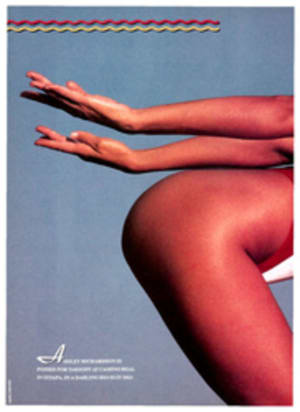
Life Without A Problem
Turia Mau payot enters the room with mischievous eyes, easy grin and purring French. She holds up her cheek to be kissed. After giving a moment's passing view of white blossoms in her hair and amused wrinkle across her brow, she offers the other cheek. Her fragrance is a complex jasmine-ginger.
Like its women, the French Polynesian island of Tahiti presents itself in a rush of sensual impressions. After only a day or two upon it, you find you have plunged into crystalline freshwater grottoes, delved in the tender flesh of pamplemousse and poisson cru, and been ruined for earth tones by the impossible colors of lagoon and flower, fish and pareu.
Turia Mau grew up one of 14 amphibious kids on the vanilla and banana plantation of her parents, Terii Terai and Tetu Paiatuiroo, in Tohaotu. She went to school until she was 13, then returned home to look after the younger children. She now has some 64 nieces and nephews, though her hold on all their names is not too firm.
"So many different children by different wives," she says. "That is very Tahitian. The guys' mentality has always been that they can run off because there's always a sister or grandmother around to take care of the kids. That's changing now, with education. But I never liked it, from age 13."
In 1965, Mau was chosen Miss Tiurai (Miss Bastille Day), and that brought her to the attention of the Tahiti tourist promotion people and, ultimately, SI swimsuit editor Jule Campbell, who arranged to photograph Mau in a bikini on Bora Bora. Turia posed for the shoot ("I remember the photographer saying, 'Just present the swimsuit' ") and then forgot about it.
Sometime later, when she was in Hong Kong on a trip to promote Tahiti, some Americans came up to her waving a sports magazine. One asked, "Is this you?"
"Yeah, I guess it is," she said, astonished. In that 1968 cover photo, she is twisting water out of her hair, eyes downcast. Inside there was a more typical photograph of her with a smile and eyes alight. Now, in her scrapbook, the ebbing colors of the photos have the look of Gauguin's primitives, though Turia is more delicate than that painter's thick-limbed Tahitians.
What came of it all? "Rien." Nothing. After Bora Bora, she worked in a pharmacy for a year or so. "Then," she says, showing dimples, "I went on vacation. For the rest of my life."
When she posed for the SI cover, she was 26 and unmarried, though she had been keeping company with Renè Payot for five years. He is a distinguished Swiss public works engineer 17 years her senior. Having worked in Morocco, Mali and Sudan, he came to Tahiti in 1962 and met Mau soon after. "Beaucoup de chance, eh?" he says now, with a courtly air. A lot of luck, indeed, because she has been with him ever since. They were married in 1976 and their daughter, Vatea, is now 17.
Renè built them a beautiful open house on a hill south of Papeete. There, on the white deck by the deep-blue pool, with a view of the fairy-tale volcanic sculptures on the island of Moorea, 12 miles across the ocean, she calls her last 20 years, "life without a problem, a beautiful life."
Annually, the Payots ski for two months in Switzerland. Turia has long since become expert. She plays consistent athletic tennis, with the result that her mother-of-pearl toenail polish is always cracked and ridged.
They have traveled widely, and at first Turia's Tahitian ways sometimes caused problems. She couldn't walk around Paris alone because she was so engagingly friendly that men presumed her a hooker. "I got scared," she says. 'I didn't know how to turn them down." Necessity has taught her to assume an un-Tahitian shell of ice.
She is intrigued to find that the SI swimsuit issue has had the ability, year after year, to shock, to prompt cancellations. She smiles at that, as would all of Tahiti, where female toplessness on the beach is perfectly acceptable. The native insouciance about dress, of course, stimulated 19th-century moralists either to celebrate the Polynesians as noble savages or—horrified—to attempt to clothe them. The latter was tried in both Tahiti and Hawaii, and the two cultures now stand in some contrast. In Tahiti, women accepted the lengths of missionary cloth and tied them into those revealing wraparound skirts known as pareus. In Hawaii, the fabric became the tentlike muumuus.
The explanation may be that Tahiti was settled by the French, who had a tendency to wink and enjoy. Hawaii, meanwhile, was swamped with immigrants from modest cultures: Chinese, Japanese, Portuguese and fire-and-brimstone New Englanders. "Oui," says Renè. "Puritans. I come from Calvinist Switzerland, and they are very strict on such things...the idiots."
At home, the Payots entertain Tahitian society, including French nuclear scientists and generals. "I am not fond of politics," Turia says. "But I know that when you help people, you're doing right." Does she regret not having pursued a modeling career? She bursts into that smile. There is a tiny gap between her front teeth. It is a signature grin. She might have been a Polynesian Lauren Hutton. She draws Renè and Vatea close.
Between becoming a wealthy model or living the life that befell her, which would she choose? "La famille," she says, and kisses her husband and daughter.
PHOTO
JOHN G. ZIMMERMAN
PHOTO
GREGORY HEISLER
WITH MOOREA IN THE DISTANCE, PAYOT, AT HOME NEAR PAPEETE, IS AWASH IN VIVID COLOR
TWO ILLUSTRATIONS

